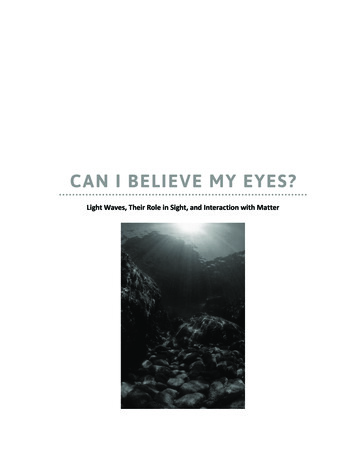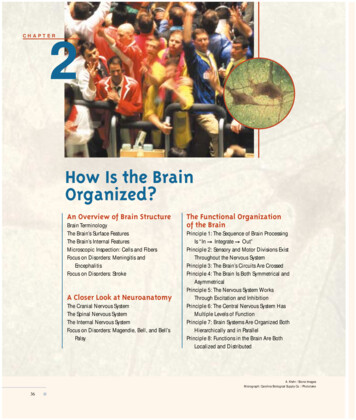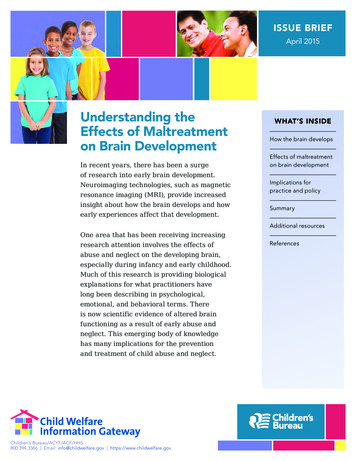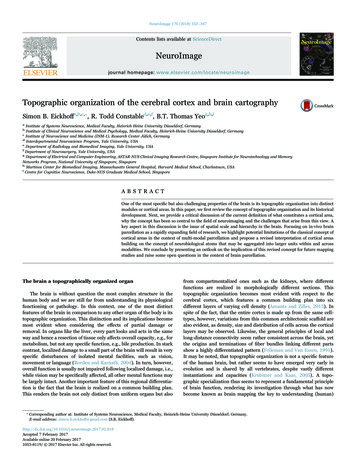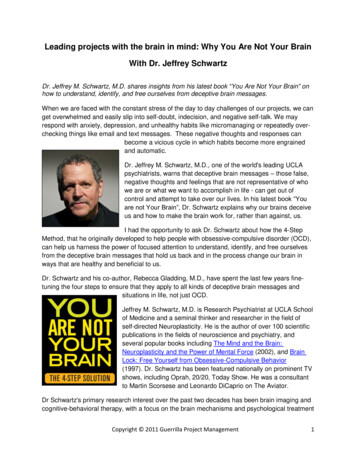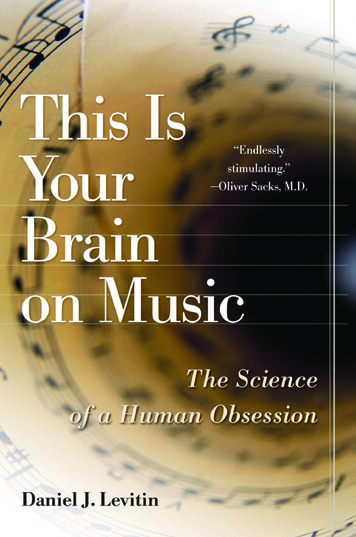
Transcription
18828 00 i-vi r7kp.qxd 5/23/06 3:16 PM Page i1234THIS IS YOUR BRAIN ON567 MUSIC 891011121314151617181920212223242526272829303132S 33R 344th Pass Pages
18828 00 i-vi r7kp.qxd 5/23/06 3:16 PM Page iii12THIS IS YOUR BRAIN ON MUSIC The Science of a Human 27Daniel J. Levitin2829303132S 33R 34DUTTON4th Pass Pages
DUTTONPublished by Penguin Group (USA) Inc.375 Hudson Street, New York, New York 10014, U.S.A.Penguin Group (Canada), 90 Eglinton Avenue East, Suite 700, Toronto, Ontario M4P 2Y3,Canada (a division of Pearson Penguin Canada Inc.); Penguin Books Ltd, 80 Strand, LondonWC2R 0RL, England; Penguin Ireland, 25 St Stephen’s Green, Dublin 2, Ireland (a divisionof Penguin Books Ltd); Penguin Group (Australia), 250 Camberwell Road, Camberwell,Victoria 3124, Australia (a division of Pearson Australia Group Pty Ltd); Penguin BooksIndia Pvt Ltd, 11 Community Centre, Panchsheel Park, New Delhi – 110 017, India; PenguinGroup (NZ), cnr Airborne and Rosedale Roads, Albany, Auckland 1310, New Zealand(a division of Pearson New Zealand Ltd); Penguin Books (South Africa) (Pty) Ltd,24 Sturdee Avenue, Rosebank, Johannesburg 2196, South AfricaPenguin Books Ltd, Registered Offices: 80 Strand, London WC2R 0RL, EnglandPublished by Dutton, a member of Penguin Group (USA) Inc.First electronic edition, August 200610 9 8 7 6 5 4 3 2 1Copyright 2006 by Daniel J. LevitinAll rights reservedREGISTERED TRADEMARK—MARCA REGISTRADALIBRARY OF CONGRESS CATALOGING-IN-PUBLICATION DATALevitin, Daniel J.This is your brain on music : the science of a human obsession / Daniel J. Levitin.p. cm.Includes bibliographical references and index.MSR ISBN 0-7865-8404-1AEB ISBN 0-7865-8405-XSet in ITC Century BookWithout limiting the rights under copyright reserved above, no part of this publication maybe reproduced, stored in or introduced into a retrieval system, or transmitted, in any form,or by any means (electronic, mechanical, photocopying, recording, or otherwise), withoutthe prior written permission of both the copyright owner and the above publisher of thisbook.The scanning, uploading, and distribution of this book via the Internet or via any othermeans without the permission of the publisher is illegal and punishable by law. Please purchaseonly authorized electronic editions, and do not participate in or encourage electronicpiracy of copyrighted materials. Your support of the author’s rights is appreciated.While the author has made every effort to provide accurate telephone numbers and Internetaddresses at the time of publication, neither the publisher nor the author assumes any responsibilityfor errors, or for changes that occur after publication. Further, the publisherdoes not have any control over and does not assume any responsibility for author or thirdpartyWeb sites or their content.Making or distributing electronic copies of this book constitutes copyright infringement and could subjectthe infringer to criminal and civil liability.www.us.penguingroup.com
18828 00 i-vi r7kp.qxd 5/23/06 3:16 PM Page vCONTENTS123456789101112IntroductionI Love Music and I Love Science—Why Would I Wantto Mix the Two?11. What Is Music?From Pitch to Timbre132. Foot TappingDiscerning Rhythm, Loudness, and Harmony553. Behind the CurtainMusic and the Mind Machine814. AnticipationWhat We Expect From Liszt (and Ludacris)1091314co 151617181920212223242526275. You Know My Name, Look Up the NumberHow We Categorize Music1296. After Dessert, Crick Was Still Four Seats Away from MeMusic, Emotion, and the Reptilian Brain2829303116532S 33R 344th Pass Pages
18828 00 i-vi r7kp.qxd 5/23/06 3:16 PM Page ontents7. What Makes a Musician?Expertise Dissected1898. My Favorite ThingsWhy Do We Like the Music We Like?2179. The Music InstinctEvolution’s #1 Hit241Appendices263Bibliographic Notes271Acknowledgments301Index303282930313233 S34 R4th Pass Pages
18828 01 1-270 r9kp.qxd 5/23/06 3:17 PM Page 1Introduction12I Love Music and I Love Science—Why Would I Want to Mix the Two?I love science, and it pains me to think that so many are terrified of thesubject or feel that choosing science means you cannot also choosecompassion, or the arts, or be awed by nature. Science is not meant tocure us of mystery, but to reinvent and reinvigorate it.—Robert Sapolsky, Why Zebras Don’t Get Ulcers, p. xiiIn the summer of 1969, when I was eleven, I bought a stereo system atthe local hi-fi shop. It cost all of the hundred dollars I had earnedweeding neighbors’ gardens that spring at seventy-five cents an hour.I spent long afternoons in my room, listening to records: Cream, theRolling Stones, Chicago, Simon and Garfunkel, Bizet, Tchaikovsky,George Shearing, and the saxophonist Boots Randolph. I didn’t listenparticularly loud, at least not compared to my college days when I actually set my loudspeakers on fire by cranking up the volume too high, butthe noise was evidently too much for my parents. My mother is a novelist; she wrote every day in the den just down the hall and played the piano for an hour every night before dinner. My father was a businessman;he worked eighty-hour weeks, forty of those hours in his office at homeon evenings and weekends. Being the businessman that he was, my father made me a proposition: He would buy me a pair of headphones if Iwould promise to use them when he was home. Those headphones forever changed the way I listened to music.The new artists that I was listening to were all exploring stereo mixing for the first time. Because the speakers that came with my hundreddollar all-in-one stereo system weren’t very good, I had never beforeheard the depth that I could hear in the headphones—the placement of4th Pass Pages34567891011121314co 151617181920212223242526272829303132S 33R 34
18828 01 1-270 r9kp.qxd 5/23/06 3:17 PM Page 22Introduction12instruments both in the left-right field and in the front-back (reverberant) space. To me, records were no longer just about the songs anymore,34but about the sound. Headphones opened up a world of sonic colors, apalette of nuances and details that went far beyond the chords and567melody, the lyrics, or a particular singer’s voice. The swampy Deep Southambience of “Green River” by Creedence, or the pastoral, open-spacebeauty of the Beatles’ “Mother Nature’s Son”; the oboes in Beethoven’s89101112Sixth (conducted by Karajan), faint and drenched in the atmosphere of alarge wood-and-stone church; the sound was an enveloping experience.Headphones also made the music more personal for me; it was suddenlycoming from inside my head, not out there in the world. This personalconnection is ultimately what drove me to become a recording engineer131415161718192021222324252627and producer.Many years later, Paul Simon told me that the sound is always whathe was after too. “The way that I listen to my own records is for thesound of them; not the chords or the lyrics—my first impression is of theoverall sound.”I dropped out of college after the incident with the speakers in mydorm room, and I joined a rock band. We got good enough to record at atwenty-four-track studio in California with a talented engineer, MarkNeedham, who went on to record hit records by Chris Isaak, Cake, andFleetwood Mac. Mark took a liking to me, probably because I was theonly one interested in going into the control room to hear back what wesounded like, while the others were more interested in getting high in between takes. Mark treated me like a producer, although I didn’t knowwhat one was at the time, asking me what the band wanted to sound like.He taught me how much of a difference to the sound a microphone could28293031make, or even the influence of how a microphone was placed. At first, Ididn’t hear some of the differences he pointed out, but he taught mewhat to listen for. “Notice that when I put this microphone closer to theguitar amp, the sound becomes fuller, rounder, and more even; but when32I put it farther back, it picks up some of the sound of the room, giving it33 S34 Ra more spacious sound, although you lose some of the midrange if I dothat.”4th Pass Pages
18828 01 1-270 r9kp.qxd 5/23/06 3:17 PM Page 3Introduction3Our band became moderately well known in San Francisco, and ourtapes played on local rock radio stations. When the band broke up—due12to the guitarist’s frequent suicide attempts and the vocalist’s nasty habitof taking nitrous oxide and cutting himself with razor blades—I found34work as a producer of other bands. I learned to hear things I had neverheard before: the difference between one microphone and another, evenbetween one brand of recording tape and another (Ampex 456 tape had567a characteristic “bump” in the low-frequency range, Scotch 250 had acharacteristic crispness in the high frequencies, and Agfa 467 a luster inthe midrange). Once I knew what to listen for, I could tell Ampex fromScotch or Agfa tape as easily as I could tell an apple from a pear or an orange. I progressed to work with other great engineers, like Leslie Ann89101112Jones (who had worked with Frank Sinatra and Bobby McFerrin), FredCatero (Chicago, Janis Joplin), and Jeffrey Norman (John Fogerty, theGrateful Dead). Even though I was the producer—the person in chargeof the sessions—I was intimidated by them all. Some of the engineers letme sit in on their sessions with other artists, such as Heart, Journey, Santana, Whitney Houston, and Aretha Franklin. I got a lifetime of educationwatching them interact with the artists, talking about subtle nuances inhow a guitar part was articulated or how a vocal performance had beendelivered. They would talk about syllables in a lyric, and choose amongten different performances. They could hear so well; how did they traintheir ears to hear things that mere mortals couldn’t?While working with small, unknown bands, I got to know the studiomanagers and engineers, and they steered me toward better and betterwork. One day an engineer didn’t show up and I spliced some tape editsfor Carlos Santana. Another time, the great producer Sandy Pearlman131415161718192021222324252627went out for lunch during a Blue Öyster Cult session and left me incharge to finish the vocals. One thing led to another, and I spent over adecade producing records in California; I was eventually lucky enoughto be able to work with many well-known musicians. But I also worked28293031with dozens of musical no-names, people who are extremely talented32but never made it. I began to wonder why some musicians becomehousehold names while others languish in obscurity. I also wonderedS 33R 344th Pass Pages
18828 01 1-270 r9kp.qxd 5/23/06 3:17 PM Page 44Introduction12why music seemed to come so easily to some and not others. Wheredoes creativity come from? Why do some songs move us so and others34leave us cold? And what about the role of perception in all of this, the uncanny ability of great musicians and engineers to hear nuances that most567of us don’t?These questions led me back to school for some answers. While stillworking as a record producer, I drove down to Stanford University twice89101112a week with Sandy Pearlman to sit in on neuropsychology lectures byKarl Pribram. I found that psychology was the field that held the answersto some of my questions—questions about memory, perception, creativity, and the common instrument underlying all of these: the human brain.But instead of finding answers, I came away with more questions—as is131415161718192021222324252627often the case in science. Each new question opened my mind to an appreciation for the complexity of music, of the world, and of the humanexperience. As the philosopher Paul Churchland notes, humans havebeen trying to understand the world throughout most of recorded history; in just the past two hundred years, our curiosity has revealed muchof what Nature had kept hidden from us: the fabric of space-time, theconstitution of matter, the many forms of energy, the origins of the universe, the nature of life itself with the discovery of DNA, and the completion of the mapping of the human genome just five years ago. But onemystery has not been solved: the mystery of the human brain and how itgives rise to thoughts and feelings, hopes and desires, love, and the experience of beauty, not to mention dance, visual art, literature, and music.28293031ing—make many people uncomfortable? For some of us, these questionsoccupy a large part of our life’s work. For others, the idea of picking music apart in this way seems tantamount to studying the chemical structure in a Goya canvas, at the expense of seeing the art that the painter32was trying to produce. The Oxford historian Martin Kemp points out a33 S34 Rsimilarity between artists and scientists. Most artists describe their workas experiments—part of a series of efforts designed to explore a com-What is music? Where does it come from? Why do some sequences ofsounds move us so, while others—such as dogs barking or cars screech-4th Pass Pages
18828 01 1-270 r9kp.qxd 5/23/06 3:17 PM Page 5Introduction5mon concern or to establish a viewpoint. My good friend and colleagueWilliam Forde Thompson (a music cognition scientist and composer at12the University of Toronto) adds that the work of both scientists andartists involves similar stages of development: a creative and exploratory34“brainstorming” stage, followed by testing and refining stages that typically involve the application of set procedures, but are often informed byadditional creative problem-solving. Artists’ studios and scientists’ labo-567ratories share similarities as well, with a large number of projects going at once, in various stages of incompletion. Both require specializedtools, and the results are—unlike the final plans for a suspension bridge,or the tallying of money in a bank account at the end of the businessday—open to interpretation. What artists and scientists have in common89101112is the ability to live in an open-ended state of interpretation and reinterpretation of the products of our work. The work of artists and scientistsis ultimately the pursuit of truth, but members of both camps understandthat truth in its very nature is contextual and changeable, dependent onpoint of view, and that today’s truths become tomorrow’s disproven hypotheses or forgotten objets d’art. One need look no further than Piaget,Freud, and Skinner to find theories that once held widespread currencyand were later overturned (or at least dramatically reevaluated). In music, a number of groups were prematurely held up as of lasting importance: Cheap Trick were hailed as the new Beatles, and at one time theRolling Stone Encyclopedia of Rock devoted as much space to Adamand the Ants as they did to U2. There were times when people couldn’timagine a day when most of the world would not know the names PaulStookey, Christopher Cross, or Mary Ford. For the artist, the goal of thepainting or musical composition is not to convey literal truth, but an as-131415161718192021222324252627pect of a universal truth that if successful, will continue to move and totouch people even as contexts, societies, and cultures change. For thescientist, the goal of a theory is to convey “truth for now”—to replace anold truth, while accepting that someday this theory, too, will be replaced28293031by a new “truth,” because that is the way science advances.32Music is unusual among all human activities for both its ubiquity andits antiquity. No known human culture now or anytime in the recorded4th Pass PagesS 33R 34
18828 01 1-270 r9kp.qxd 5/23/06 3:17 PM Page 66Introduction12past lacked music. Some of the oldest physical artifacts found in humanand protohuman excavation sites are musical instruments: bone flutes34and animal skins stretched over tree stumps to make drums. Wheneverhumans come together for any reason, music is there: weddings, funer-567als, graduation from college, men marching off to war, stadium sportingevents, a night on the town, prayer, a romantic dinner, mothers rockingtheir infants to sleep, and college students studying with music as a89101112background. Even more so in nonindustrialized cultures than in modernWestern societies, music is and was part of the fabric of everyday life.Only relatively recently in our own culture, five hundred years or so ago,did a distinction arise that cut society in two, forming separate classes ofmusic performers and music listeners. Throughout most of the world131415161718192021222324252627and for most of human history, music making was as natural an activityas breathing and walking, and everyone participated. Concert halls, dedicated to the performance of music, arose only in the last several centuries.Jim Ferguson, whom I have known since high school, is now a professor of anthropology. Jim is one of the funniest and most fiercely intelligent people I know, but he is shy—I don’t know how he manages toteach his lecture courses. For his doctoral degree at Harvard, he performed fieldwork in Lesotho, a small nation completely surrounded bySouth Africa. There, studying and interacting with local villagers, Jim patiently earned their trust until one day he was asked to join in one oftheir songs. So, typically, when asked to sing with these Sotho villagers,Jim said in a soft voice, “I don’t sing,” and it was true: We had been inhigh school band together and although he was an excellent oboe player,he couldn’t carry a tune in a bucket. The villagers found his objection28293031puzzling and inexplicable. The Sotho consider singing an ordinary,everyday activity performed by everyone, young and old, men andwomen, not an activity reserved for a special few.Our culture, and indeed our very language, makes a distinction be-32tween a class of expert performers—the Arthur Rubinsteins, Ella33 S34 RFitzgeralds, Paul McCartneys—and the rest of us. The rest of us paymoney to hear the experts entertain us. Jim knew that he wasn’t much of4th Pass Pages
18828 01 1-270 r9kp.qxd 5/23/06 3:17 PM Page 7Introduction7a singer or dancer, and to him, a public display of singing and dancing implied he thought himself an expert. The villagers just stared at Jim and12said, “What do you mean you don’t sing?! You talk!” Jim told me later, “Itwas as odd to them as if I told them that I couldn’t walk or dance, even34though I have both my legs.” Singing and dancing were a natural activityin everybody’s lives, seamlessly integrated and involving everyone. TheSesotho verb for singing (ho bina), as in many of the world’s languages,567also means to dance; there is no distinction, since it is assumed thatsinging involves bodily movement.A couple of generations ago, before television, many families wouldsit around and play music together for entertainment. Nowadays there isa great emphasis on technique and skill, and whether a musician is “good89101112enough” to play for others. Music making has become a somewhat reserved activity in our culture, and the rest of us listen. The music industry is one of the largest in the United States, employing hundreds ofthousands of people. Album sales alone bring in 30 billion a year, andthis figure doesn’t even account for concert ticket sales, the thousands ofbands playing Friday nights at saloons all over North America, or thethirty billion songs that were downloaded free through peer-to-peer filesharing in 2005. Americans spend more money on music than on sex orprescription drugs. Given this voracious consumption, I would say thatmost Americans qualify as expert music listeners. We have the cognitivecapacity to detect wrong notes, to find music we enjoy, to rememberhundreds of melodies, and to tap our feet in time with the music—an activity that involves a process of meter extraction so complicated thatmost computers cannot do it. Why do we listen to music, and why are wewilling to spend so much money on music listening? Two concert tickets131415161718192021222324252627can easily cost as much as a week’s food allowance for a family of four,and one CD costs about the same as a work shirt, eight loaves of bread,or basic phone service for a month. Understanding why we like musicand what draws us to it is a window on the essence of human nature.2829303132To ask questions about a basic, and omnipresent human ability is to implicitly ask questions about evolution. Animals evolved certain physical4th Pass PagesS 33R 34
18828 01 1-270 r9kp.qxd 5/23/06 3:17 PM Page 88Introduction12forms as a response to their environment, and the characteristics thatconferred an advantage for mating were passed down to the next gener-34ation through the genes.A subtle point in Darwinian theory is that living organisms—whether567plants, viruses, insects, or animals—coevolved with the physical world.In other words, while all living things are changing in response to theworld, the world is also changing in response to them. If one species de-89101112velops a mechanism to keep away a particular predator, that predator’sspecies is then under evolutionary pressure either to develop a means toovercome that defense or to find another food source. Natural selectionis an arms race of physical morphologies changing to catch up with oneanother.131415161718192021222324252627A relatively new scientific field, evolutionary psychology, extends thenotion of evolution from the physical to the realm of the mental. Mymentor when I was a student at Stanford University, the cognitive psychologist Roger Shepard, notes that not just our bodies but our mindsare the product of millions of years of evolution. Our thought patterns,our predispositions to solve problems in certain ways, our sensory systems—such as the ability to see color (and the particular colors wesee)—are all products of evolution. Shepard pushes the point still further: Our minds coevolved with the physical world, changing in responseto ever-changing conditions. Three of Shepard’s students, Leda Cosmides and John Tooby of the University of California at Santa Barbara,and Geoffrey Miller of the University of New Mexico, are among those atthe forefront of this new field. Researchers in this field believe that theycan learn a lot about human behavior by considering the evolution of themind. What function did music serve humankind as we were evolving28293031and developing? Certainly the music of fifty thousand and one hundredthousand years ago is very different from Beethoven, Van Halen, or Eminem. As our brains have evolved, so has the music we make with them,and the music that we want to hear. Did particular regions and pathways32evolve in our brains specifically for making and listening to music?33 S34 RContrary to the old, simplistic notion that art and music are processed in the right hemisphere of our brains, with language and mathe-4th Pass Pages
18828 01 1-270 r9kp.qxd 5/23/06 3:17 PM Page 9Introduction9matics in the left, recent findings from my laboratory and those of mycolleagues are showing us that music is distributed throughout the brain.12Through studies of people with brain damage, we’ve seen patients whohave lost the ability to read a newspaper but can still read music, or in-34dividuals who can play the piano but lack the motor coordination tobutton their own sweater. Music listening, performance, and composition engage nearly every area of the brain that we have so far identified,567and involve nearly every neural subsystem. Could this fact account forclaims that music listening exercises other parts of our minds; that listening to Mozart twenty minutes a day will make us smarter?The power of music to evoke emotions is harnessed by advertisingexecutives, filmmakers, military commanders, and mothers. Advertisers89101112use music to make a soft drink, beer, running shoe, or car seem more hipthan their competitors’. Film directors use music to tell us how to feelabout scenes that otherwise might be ambiguous, or to augment our feelings at particularly dramatic moments. Think of a typical chase scene inan action film, or the music that might accompany a lone woman climbing a staircase in a dark old mansion: Music is being used to manipulateour emotions, and we tend to accept, if not outright enjoy, the power ofmusic to make us experience these different feelings. Mothers throughout the world, and as far back in time as we can imagine, have used softsinging to soothe their babies to sleep, or to distract them from something that has made them cry.Many people who love music profess to know nothing about it. I’vefound that many of my colleagues who study difficult, intricate topicssuch as neurochemistry or psychopharmacology feel unprepared to deal131415161718192021222324252627with research in the neuroscience of music. And who can blame them?Music theorists have an arcane, rarified set of terms and rules that are asobscure as some of the most esoteric domains of mathematics. To thenonmusician, the blobs of ink on a page that we call music notation28293031might just as well be the notations of mathematical set theory. Talk of32keys, cadences, modulation, and transposition can be baffling.Yet every one of my colleagues who feels intimidated by such jargonS 33R 344th Pass Pages
18828 01 1-270 r9kp.qxd 5/23/06 3:17 PM Page 1010Introduction12can tell me the music that he or she likes. My friend Norman White is aworld authority on the hippocampus in rats, and how they remember dif-34ferent places they’ve visited. He is a huge jazz fan, and can talk expertlyabout his favorite artists. He can instantly tell the difference between567Duke Ellington and Count Basie by the sound of the music, and can eventell early Louis Armstrong from late. Norm doesn’t have any knowledgeabout music in the technical sense—he can tell me that he likes a certain89101112song, but he can’t tell me what the names of the chords are. He is, however, an expert in knowing what he likes. This is not at all unusual, ofcourse. Many of us have a practical knowledge of things we like, and cancommunicate our preferences without possessing the technical knowledge of the true expert. I know that I prefer the chocolate cake at one131415161718192021222324252627restaurant I often go to, over the chocolate cake at my neighborhoodcoffee shop. But only a chef would be able to analyze the cake—to decompose the taste experience into its elements—by describing thedifferences in the kind of flour, or the shortening, or the type of chocolate used.It’s a shame that many people are intimidated by the jargon musicians, music theorists, and cognitive scientists throw around. There isspecialized vocabulary in every field of inquiry (try to make sense of afull blood-analysis report from your doctor). But in the case of music,music experts and scientists could do a better job of making their workaccessible. That is something I tried to accomplish in this book. The unnatural gap that has grown between musical performance and music listening has been paralleled by a gap between those who love music (andlove to talk about it) and those who are discovering new things abouthow it works.28293031A feeling my students often confide to me is that they love life and itsmysteries, and they’re afraid that too much education will steal awaymany of life’s simple pleasures. Robert Sapolsky’s students have probably confided much the same to him, and I myself felt the same anxiety in321979, when I moved to Boston to attend the Berklee College of Music.33 S34 RWhat if I took a scholarly approach to studying music and, in analyzing4th Pass Pages
18828 01 1-270 r9kp.qxd 5/23/06 3:17 PM Page 11Introduction11it, stripped it of its mysteries? What if I became so knowledgeable aboutmusic that I no longer took pleasure from it?12I still take as much pleasure from music as I did from that cheap hi-fithrough those headphones. The more I learned about music and about34science the more fascinating they became, and the more I was able to appreciate people who are really good at them. Like science, music overthe years has proved to be an adventure, never experienced exactly the567same way twice. It has been a source of continual surprise and satisfaction for me. It turns out science and music aren’t such a bad mix.This book is about the science of music, from the perspective of cognitive neuroscience—the field that is at the intersection of psychologyand neurology. I’ll discuss some of the latest studies I and other re-89101112searchers in our field have conducted on music, musical meaning, andmusical pleasure. They offer new insights into profound questions. Ifall of us hear music differently, how can we account for pieces thatseem to move so many people—Handel’s Messiah or Don McLean’s“Vincent (Starry Starry Night)” for example? On the other hand, if we allhear music in the same way, how can we account for wide differences inmusical preference—why is it that one man’s Mozart is another man’sMadonna?The mind has been opened up in the last few years by the explodingfield of neuroscience and the new approaches in psychology due to newbrain-imaging technologies, drugs able to manipulate neurotransmitterssuch as dopamine and serotonin, and plain old scientific pursuit. Lesswell known are the extraordinary advances we have been able to makein modeling how our neurons network, thanks to the continuing revolution in computer technology. We are coming to understand computa-131415161718192021222324252627tional systems in our head like never before. Language now seems to besubstantially hardwired into our brains. Even consciousness itself is nolonger hopelessly shrouded in a mystical fog, but is rather somethingthat emerges from observable physical systems. But no one until now28293031has taken all this new work together and used it to elucidate what is for32me the most beautiful human obsession. Your brain on music is a way toS 33R 344th Pass Pages
18828 01 1-270 r9kp.qxd 5/23/06 3:17 PM Page 1212Introduction12understand the de
Levitin, Daniel J. This is your brain on music : the science of a human obsession / Daniel J. Levitin. p. cm. Includes bibliographical references and index. MSR ISBN 0-7865-8404-1 AEB ISBN 0-7865-8405-X Set in ITC Century Book Without limiting the rights under




